To kill something prettier: just kukri ...
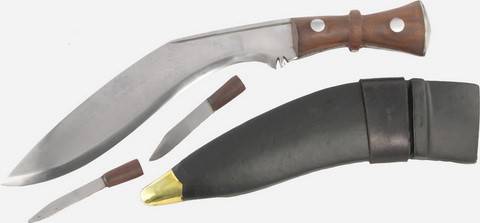
Traditional kukri with all accessories. Two more small knives are inserted into the sheath.
The traditional Nepali blade of the kukri is forged from high-carbon quality steel with zone quenching, similar to Japanese blades. That is, it is not fully hardened, but mainly its cutting part, and the blade itself has a sickle shape, and is sharpened on the inside of the blade. The lower part of the blade expands in such a way that the center of gravity shifts to its point. Such an unusual form, however, is fully justified, since it makes it possible with the minimum effort to deliver strong slashing blows.
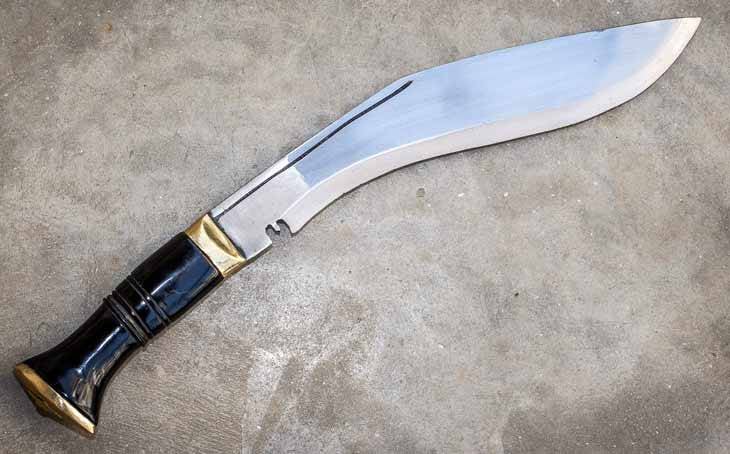
Externally, kukri is very simple, but also beautiful. There is nothing superfluous in it. But then every little thing in it has a ritual significance.
Since this is a local weapon, in the course of time there is practically no single detail in it that human imagination would not give a certain meaning, and they even have their own names. For example, at the base of the blade of a classic kukri there is a figured neckline, which is called “cho.”
The triangular shape of the blade section is also not “just like that,” but the trinity of the gods Shiva, Vishnu and Brahma. Rings on the handle of the kukri, which allow you to confidently hold it even with wet hands, actually symbolize the levels of the universe, that is, they are made on it so that the owner of the knife does not forget about it!
"Cho", that is, the recess at the base of the blade has a different shape, and it means "Shiva's trident" - the main symbol of power and the main attribute of this Hindu deity. There is a “cho” that resembles a “footprint from a cow,” and then it will already be a symbol of the death goddess Kali. Well, and the cow, as it is known, in Hinduism is considered a sacred animal. Such “chos” are characteristic of kukri cheinpur, named after the Nepalese village of Chenpur, in which they are produced.
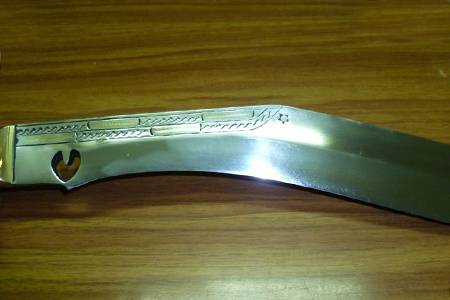
This is the dove-eye kukri blade from Chitlandge.
The name in honor of the small town of Chitland, located in the east of Nepal, was also obtained by the kukri of Chitland, a characteristic feature of which is the opening of a specific shape (“pigeon eye”) in its blade.
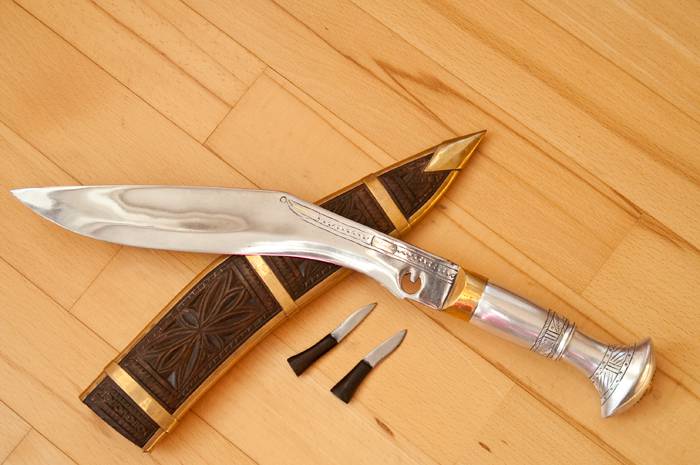
Another kukri of the same type with a silver handle.
In the village of Bhojpur, also in the east of Nepal, several models of kukri are produced at once. It is believed that kukri "from Bhojpur" is in some sense the ancestor of all other types of kukri. Therefore, they occupy a special place in the Nepalese culture. They are also considered a talisman of a house that protects a home and gives its owners prosperity and good fortune, and they put kukri under a pillow for a good night’s sleep, wear it during a wedding ceremony, and put it together with the deceased into the grave, since it is believed that they should will play the role of passes into the kingdom of heaven.
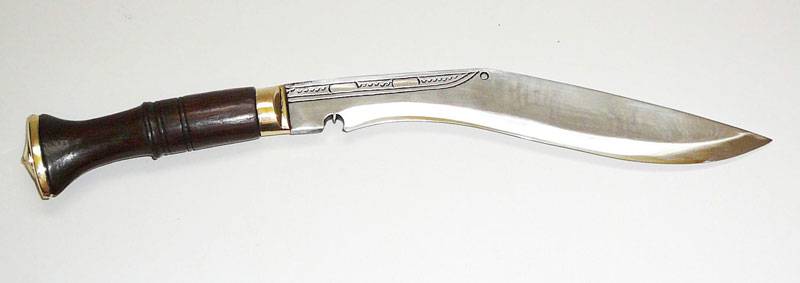
Kukri Sirupati.
There are kukri varieties "Sirupati". The blade of the “Sirupati” resembles a leaf of the Sira plant growing in the mountains (hence the name) and it is narrower and more direct than other kukri species, which gives it a very elegant look, and ... makes it comfortable for the most varied work .
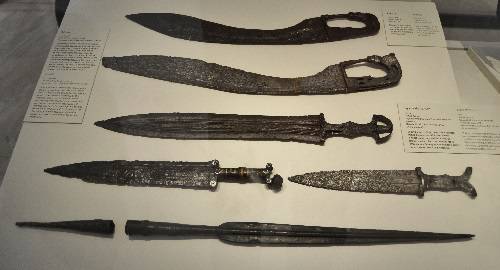
National Archaeological Museum in Madrid. Swords are straight and with an offset center of gravity of the blade.
Where did the kukri come from and what story his origins historians argue so far. It looks like it, however, very roughly, the sword khopesh, common among the ancient Egyptians, and the characteristic form of a copis, used in ancient Greece.
Kepis is even in the Archaeological Museum of the city of Anapa, that is, swords of this type in the Attic era were widespread, and from Spain to the Northern Black Sea region.
It is believed that the Greek Copis is the ancestor of the Iberian Mahaira sword. It looks like Ethiopian sweating, as well as Turkish yataghans, although their blades have practically no extension to the tip. There is an assumption that the soldiers of Alexander the Great, who used the same form of swords, brought it into Hindustan territory. Indeed, if you look at it, the kukri looks like a smaller version of the ancient kopis, though it has a very different handle shape.
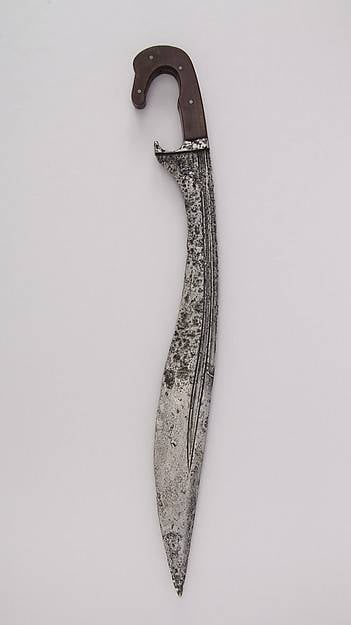
Mahaira (or falcata) from the Metropolitan Museum in New York.
Due to the fact that the dimensions of the ancient swords with a displaced center of gravity with a blade with a reverse bend were quite large, the sword strongly "pulled" the arm forward when struck, and in order that it did not break out of it, a bend head ". The kukri have no such bend of the handle, but, nevertheless, its rear part also has an extension that helps to keep it on impact. As to antiquity, in the museums of Nepal there are kukri, made in the XV century. Surely there were earlier patterns, but they, most likely, were re-crafted as they wear out to newer ones.
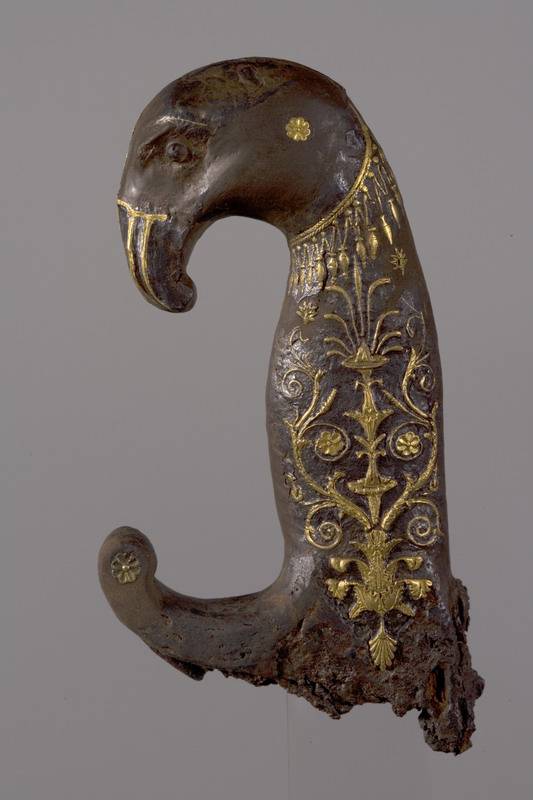
The handle of the mahaira was of such a shape that it would not break loose from the hand.
Gurkha themselves deify their knife and attribute the most unusual properties to it. For example, that he is “alive” and does not “love” certain effects. So, if it is rotated in the hand, it can easily be pulled out of the hand, because “he does not like it”. Piercing strikes are not very convenient for them, as well as fencing, since kukri is intended for other purposes. So the Gurkha boys were taught to treat him since childhood. At the same time, if we ignore the study of various specific methods, it can be noted that the kukri ergonomics are so well thought out and perfect that it allows using this type of knife without any special training whatsoever.
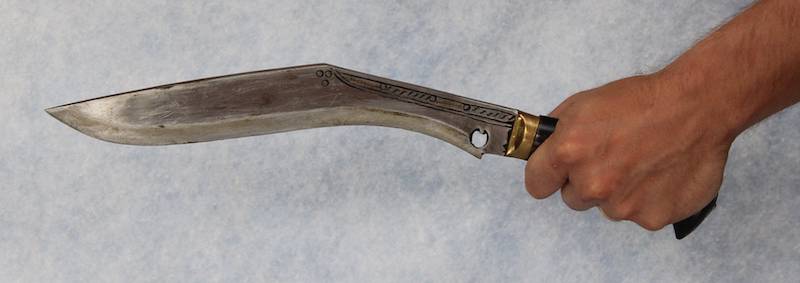
It is necessary to be able to use kukri and, first of all, to hold it correctly in your hand.
A strange belief is connected with the kukri that, being removed from the scabbard, it cannot be inserted back without letting him feel the “taste of blood”. Therefore, without a particularly good reason, the Gurkhas never exposed them. And if this happened, then before removing it, it was necessary to cut a finger, and moisten the blade with this blood. That is just so, in order to “scare”, Gurkha Kukri is not extracted from the scabbard, such behavior is considered unworthy for a man. But if he extracted it, then his opponent needs to take care of himself!
Kukri in 18 inches is something!
The length of kukri traditionally measured in inches. Moreover, the typical length of the blade kukri 9 inches. Different there "mini-kukri" is nonsense. Butt it can have a thickness of from 8 to 12 mm. Interestingly, the kukri still continues to be used as a standard cold weapon both by the police and the military formations of Nepal, as well as by gurkas-mercenaries, traditionally serving in the English army.
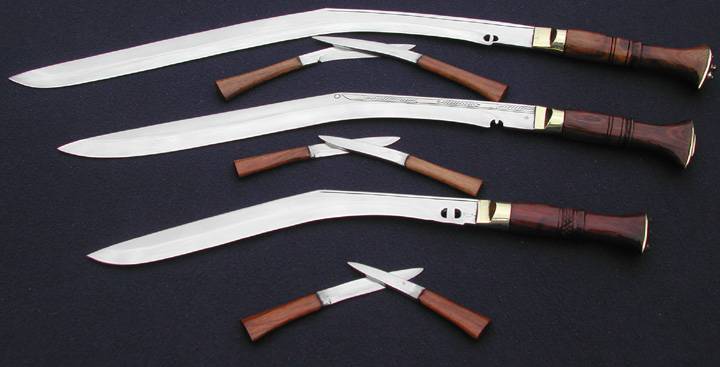
Kukri in 30, 25 and 20 inches. This is not even a knife. Knives satellites also increased. It would be interesting to hold these “monsters” (weight 2 kg, length 75 cm!) In their hands and use them. By the way, the price of 30-inch Kukri in Nepal is 229 dollars. You can buy directly in Russia, but the delivery will cost more in 40!
More recently, kukri forged from parts of railway equipment and decommissioned rails. Today, masters are increasingly using Swedish and German automotive springs, and Japanese are used less frequently.
Kukri are forged by hand, like hundreds of years ago, so even blades of the same type are still a little bit different. Among the characteristic features of the Kukri blade are the presence of dyes (depressions on the blade) of chirra and hol. A dol of the first type runs across the entire blade and can reach a width of 20 mm. There are blades with three or even five valleys of chirra, going from the handle to the wide part of the blade. Such blades look very unusual and unusual. That is, in this case it is not even, but wavy. The hol - short and narrow goes along the butt, and it starts from the handle, and ends at the bend point.
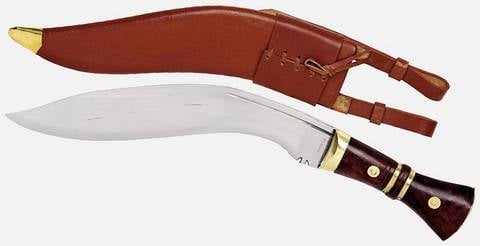
Kukri with a narrow hollow and a rivet handle.
And this is how the blade shank breaks out at the top.
The kukri handle is traditionally made of polished water buffalo horns and hard and expensive woods (for example, rosewood), and earlier the horn of the local rhinoceros and ivory went on them. Handles most often sit down, but there are also those that are mounted on the blade shank with the help of two copper rivets. Sometimes a kukri has a brass or copper handle (now even made of aluminum!). Such a handle is heavier than a wooden one, but it is distinguished by great strength and is a kind of counterbalance to the blade. Make the handle and silver.
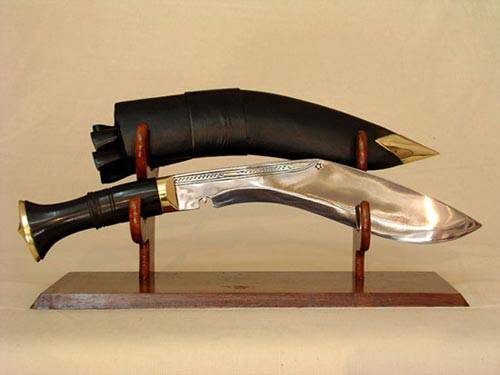
Kukri with a scabbard on a special stand.
The sheaths are usually made of wood and covered with leather, and in them (on the inside), as well as in the sheath of a Japanese sword, there are also containers for two small knives. The first knife (card) was used for various small household needs, but the second knife (chakmak) was not sharpened, had a rough surface, and was intended for straightening sharpening the blade of the main blade. As a rule, army kukri do not have such additional knives, as they appeared already by the end of the twentieth century, when the Gorki soldiers again decided to turn to their historical and military roots and traditions.
Kukri extremes are not approved, but they exist. In this, for example, some obviously "curve" handle. And why is she like that?
Now a little about the legality of owning such an exotic knife as kukri. It would seem that this is the real cold weapon, but ... according to the legislation of the Russian Federation, it is not kukri that are considered to be cold arms! And the thing is that the bend of his butt in relation to the upper part is much larger than 15 millimeters, and the angle of the blade edge has more 70 degrees.
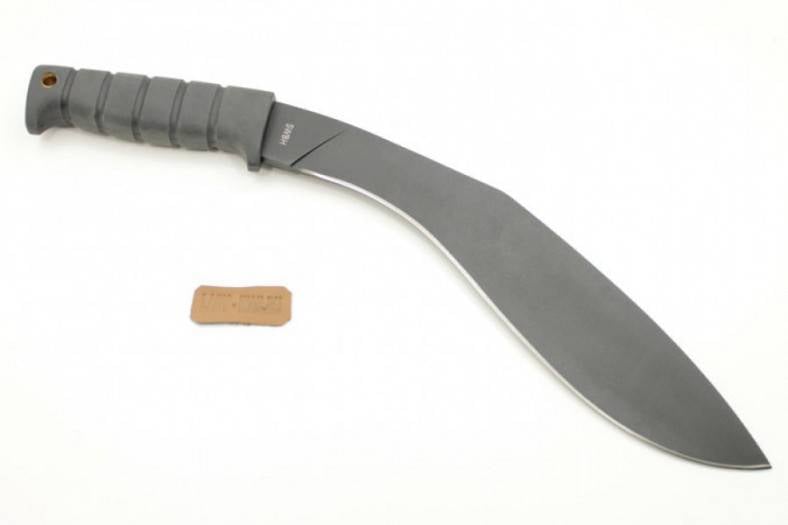
Kukri, made in America. This is a perversion, although, of course, it is disguised perfectly. You can advertise, you can sell. But ... in the kukri everything is thought out for centuries. And if there is no “Shiva's trident” on his blade, then ... in this place on it, sooner or later a crack forms and this “crafts” will only be thrown away! "The gods are taking revenge!"
Thus, referring to the relevant State Standards, we see that the combination of all these signs gives the right to rightfully refer kukri to ... the category of household items, since it is very difficult to give a thrusting blow to them.
Kukri with a blade in 9 inches. From my own experience I can say that even this length is more than enough!
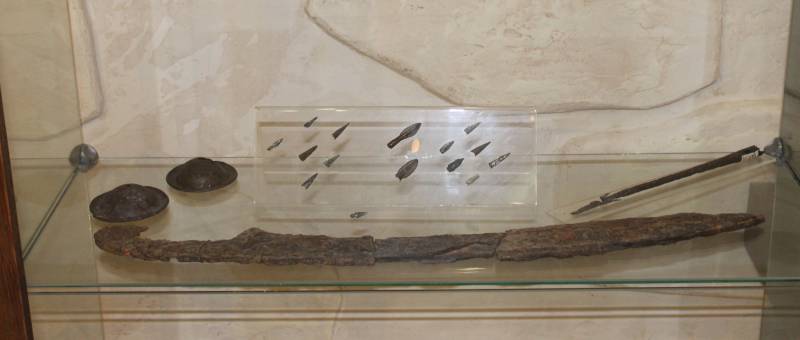
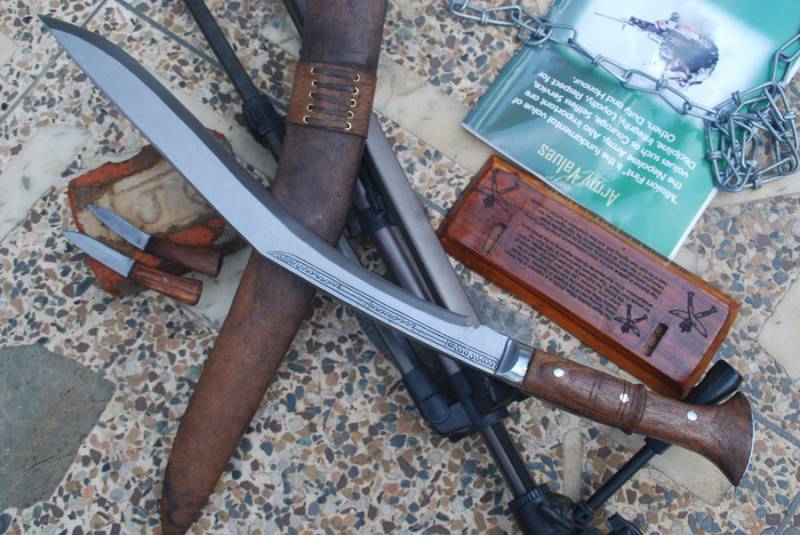
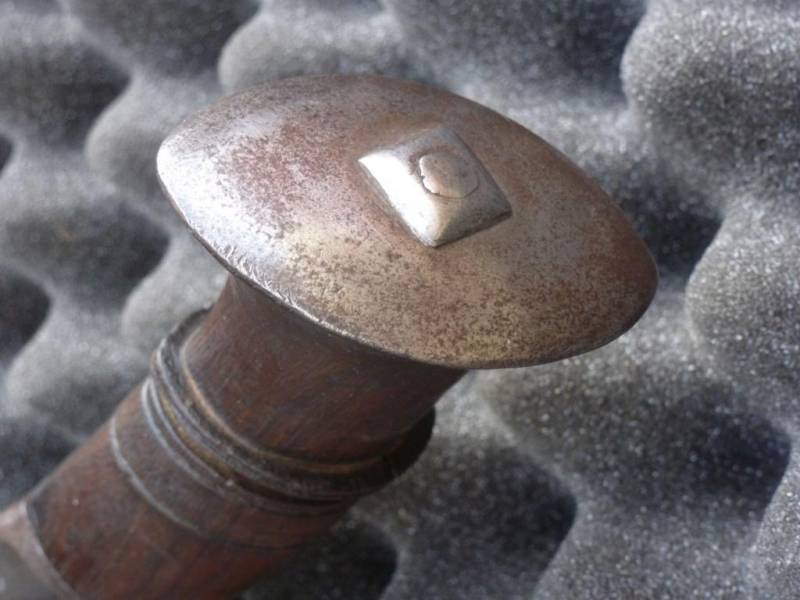
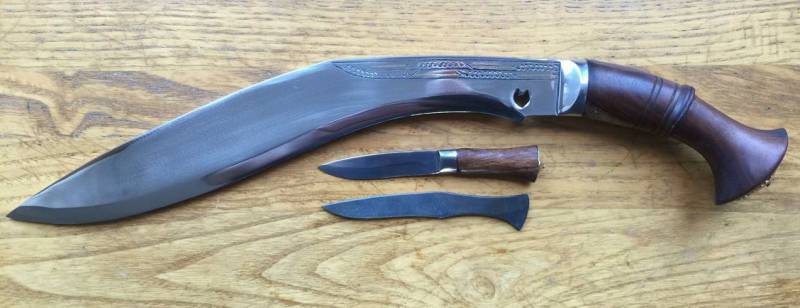
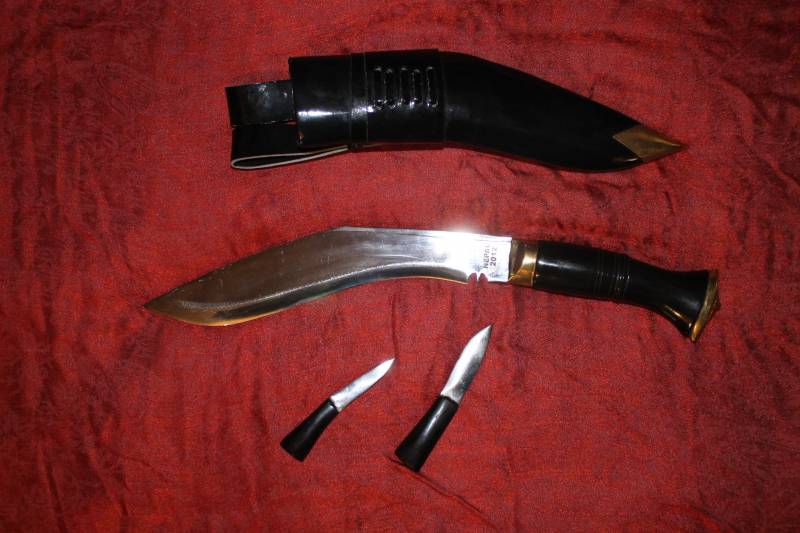
Information